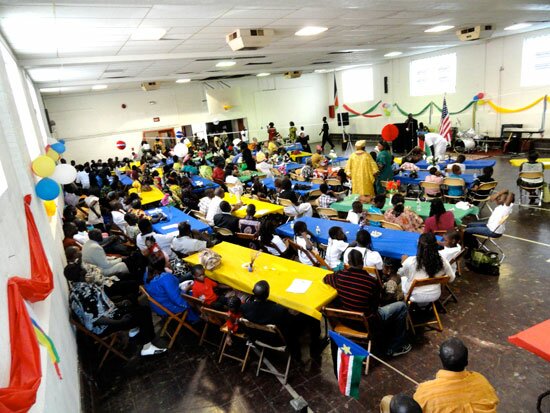BUFFALO, N.Y. — The crowd—dancing, cheering, laughing—was exuberant.
But it was more than joy that the 200 or so revelers shared as they convened at Holy Cross Church on Maryland Street last Saturday—July 9—to celebrate the birth of South Sudan, the world’s newest nation.
Memories held these people together.
Many were from South Sudan, and they were survivors. Some had experienced war; in their minds, they could still picture the terror that had forced their families to flee Sudan during the country’s brutal, north-south civil war. Others—children and even young adults born in exile—had never had the opportunity to visit their homeland.
Now they could go.
How long had they waited for this day?
Sudan’s civil war, which pitted the country’s largely Muslim north against its predominantly Christian and animist south, began in 1983 and lasted more than two decades. The reasons for the conflict were complex, with religious, ethnic, economic and political differences dividing the factions.
By the time the two sides signed a peace deal in 2005, some 2 million people, mostly civilians, had died in killings and from famine and disease associated with the hostilities.
For the war-weary, for those who had lost so much, the declaration of independence of the Republic of South Sudan on July 9 marked a new beginning. Though the country starts its life as a troubled nation, with problems ranging from widespread poverty to continued disputes with the north over oil, Saturday was a time to celebrate.
The festivities at Holy Cross Church, organized by Western New York’s South Sudanese community, opened with the raising of the flag of South Sudan. A children’s choir sang. Pastor Ronald Sajdak, whose East Side church has helped South Sudanese refugees settle in Buffalo, offered a prayer.
Later, a band played. Women, some wearing dresses in striking shades of yellow and green, hauled out a feast of lamb, fish, spinach, beans and flat bread. Speakers discussed the history of South Sudan and the years of struggle that had preceded the rise of the new nation.
In America, the Sudanese civil war’s most recognized victims are probably the Lost Boys of Sudan, youths who escaped the conflict by walking from their home villages in the south to refugee camps in Ethiopia and Kenya—a thousand-mile odyssey.
But every survivor has a different story, and on Saturday, there were so many to tell.
Mary Dour, 23, a student at D’Youville College, put her sentiments simply: “Now, we have freedom,” she said, beaming.
This January, Dour was among many South Sudanese living in Western New York Sudanese who traveled to Toronto to vote in a referendum on their country’s independence.
On Saturday, she served as an emcee for the local celebration.
Dour has never been to South Sudan—her family left the region before she was born. But this December, she will step foot on South Sudanese soil for the first time.
When she does, she will see her homeland as what her countrymen had long imagined it would be: an independent nation, free, at last, to decide its own fate.

A new way forward
A version of this story was also published in Artvoice, Buffalo’s newsweekly.


